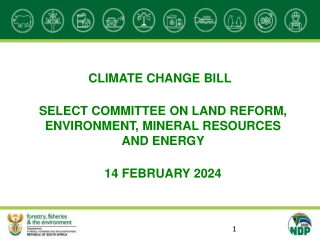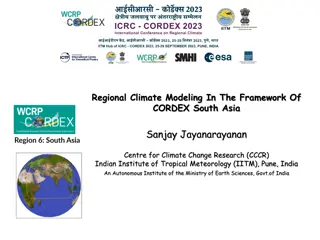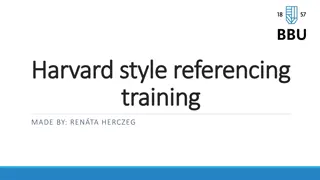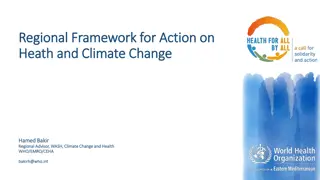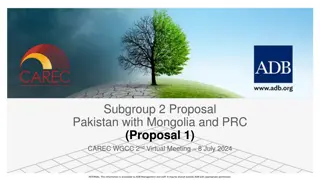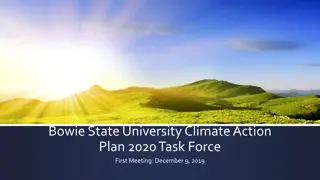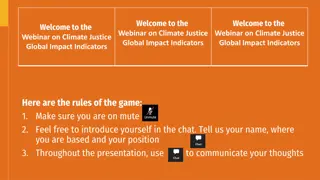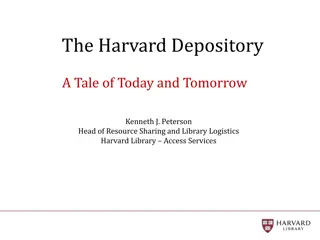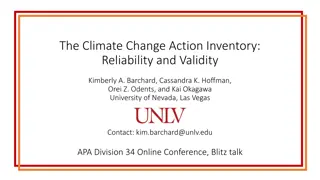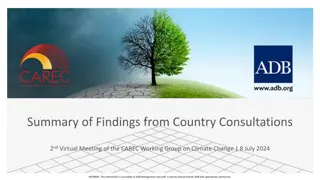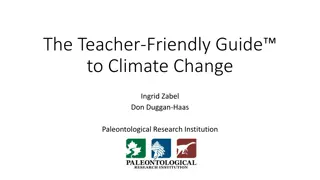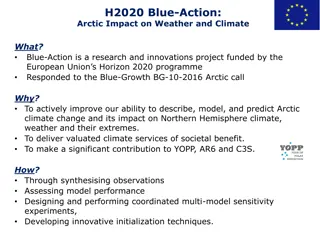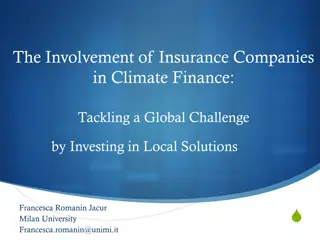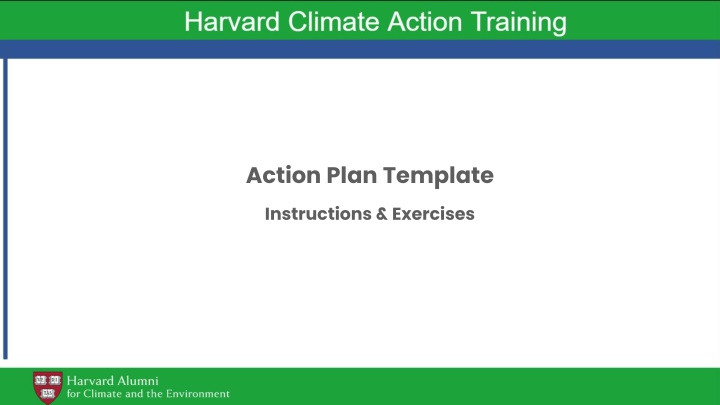
Harvard Climate Action Training - Personal Action Plan
Welcome to the Harvard Climate Action Training! Create your Personal Action Plan to combat climate change within your organization. Use the Template to prioritize action, engage stakeholders, and set SMART goals. Dive into exercises on issues, SWOT analysis, stakeholders, and goal-setting. Participate in pre-work motivators to deepen your understanding of motivations and organizational attitudes towards climate change.
Download Presentation

Please find below an Image/Link to download the presentation.
The content on the website is provided AS IS for your information and personal use only. It may not be sold, licensed, or shared on other websites without obtaining consent from the author. If you encounter any issues during the download, it is possible that the publisher has removed the file from their server.
You are allowed to download the files provided on this website for personal or commercial use, subject to the condition that they are used lawfully. All files are the property of their respective owners.
The content on the website is provided AS IS for your information and personal use only. It may not be sold, licensed, or shared on other websites without obtaining consent from the author.
E N D
Presentation Transcript
Action Plan Template Instructions & Exercises 1
Welcome From all of us at the Harvard Alumni Climate and Environment special interest group ( HACE ) welcome to the Harvard Climate Action Training. We re thrilled you re here, and continuing your journey as a sustainability advocate and transforming your organizations. This Personal Action Plan Template ( the Template ) will guide you to create an action plan to begin to combat climate change within your organization, while being mindful of environmental sustainability and environmental justice. The Template can be: a tool to record and make sense of the information you ll get through the Training Sessions; a framework to prioritize action and focus on areas where you re most likely to make an impact; and a presentation you can share with others to incorporate their views and gain their support. Scope of the Action Plan Template The Template is designed for a busy individual (you) to begin to act within your organization. It assumes your organization doesn t yet have a full climate or sustainability strategy and needs leadership (you again) to get them started. Climate is the focus of the Template. The tools can be applied to the broader scope of environmental sustainability. As you proceed, you should also take a view beyond your organization to consider environmental justice and how people and communities around your organization are also affected. 2
Overview of the Template Sections of the Personal Action Plan Using the Personal Action Plan Template Start with a draft and iterate. You can return to exercises throughout the Climate Action Training. Begin with information you know already and learn in the Climate Action Training. You can dive deeper with additional research if you need. You can do this work alone, but you ll do a better job and build community by engaging with others, including in Small Group Actions Sessions. The Template has plain formatting so you can easily cut and paste into your organization s format if needed. Understand your motivations and your organization s starting point Pre-work Motivators Session 1 Issues Select an issue that you want to work on Assess your your organization s Strengths, Weaknesses, Opportunities And Threats Session 2 SWOT Session 3 Stakeholders Identify your stakeholders and allies Session 4 & 5 Plan Set a SMART goal and make your plan 3
Pre-work Motivators Understand your motivations and your organization's starting point The purpose of this pre-work is to deepen your understanding of your motivations for joining the Climate Action Training, and of your organization s actions and attitude in relation to climate change. Here are some ADDITIONAL RESOURCES if you would like to go deeper: Watch How to transform apocalypse fatigue into action on global warming https://www.youtube.com/watch?v=F5h6ynoq8u M Understanding where we start is essential to moving forward and building a realistic action plan. Read The Journey to a Sustainable Business Whitepaper https://www.erm.com/insights/the- journey-to-a-sustainable-business-navigating- the-road-ahead There are three exercises: Self reflection Talk to some colleagues within your organization or industry Identify your organization's current attitude(s) to climate change 4
Pre-work Motivators Exercise 1: Self-reflection Instructions: Take a moment to think about what brings you the most joy and meaning: Your relationships & family? Your experiences of the world? The wellbeing of your community?... These are your sustainability motivators. They are the reasons WHY you would invest in sustainability and combat climate change. Now think how climate change could impact these important motivators. Express these in some way either write them down in the table, draw a picture or make a video that tells the story. You ll have an opportunity to share these (if you want) in your Small Group Action Sessions. 5
Pre-work Motivators Climate change motivators These things bring my life joy and meaning Climate change could impact them by <Insert a picture or a drawing that represents one reason climate change matters to you> 6
Pre-work Motivators Exercise 2: Talk to colleagues Instructions: Talk to three people in your organization or industry with different functions (e.g. operations, finance, HR, product, sales...) and ask them five questions listed in the interview guide. The goal is to learn, not to convince them of anything (yet). If you find an ally, you may want to involve them somehow in the Climate Action Training. It s OK if people do not know answers to every question, that is also information. 7
Pre-work Motivators Baseline interview notes <Person/Title A> How is climate change impacting our organization, our vendors/clients, our industry now? And in five years? What are our organization s greatest contributions to human-caused climate change1? What is our organization already doing/planning to do to combat human-caused climate change? What else would you like to see our organization do to combat human-caused climate change? 1. Human activities cause climate change in two main ways. First by releasing greenhouse gasses such a carbon dioxide and methane. Second by releasing fine particles into the air (air pollution) that retain heat. Black Carbon (or soot from burning things) is the main one in this second category. 8
Pre-work Motivators Baseline interview notes <Person/Title B> How is climate change impacting our organization, our vendors/clients, our industry now? And in five years? What are our organization s greatest contributions to human-caused climate change1? What is our organization already doing/planning to do to combat human-caused climate change? What else would you like to see our organization do to combat human-caused climate change? 1. Human activities cause climate change in two main ways. First by releasing greenhouse gasses such a carbon dioxide and methane. Second by releasing fine particles into the air (air pollution) that retain heat. Black Carbon (or soot form burning things) is the main one in this second category. 9
Pre-work Motivators Baseline interview notes <Person/Title C> How is climate change impacting our organization, our vendors/clients, our industry now? And in five years? What are our organization s greatest contributions to human-caused climate change1? What is our organization already doing/planning to do to combat human-caused climate change? What else would you like to see our organization do to combat human-caused climate change? 1. Human activities cause climate change in two main ways. First by releasing greenhouse gasses such a carbon dioxide and methane. Second by releasing fine particles into the air (air pollution) that retain heat. Black Carbon (or soot form burning things) is the main one in this second category. 10
Pre-work Motivators Exercise 3: Identify current attitude(s) to climate change within your organization Instructions: Understanding where your organization starts is essential to identifying the best opportunities for action, and how to communicate internally with key decision makers. Read the five approaches to sustainability and their indicators on the following slide. Listen for these in your conversations within your organization. In column 3, identify your organization s main approach. Different people inside your organization may have different approaches: you can also include these in column three. To go even further you could also research and include your main competitors. 11
Pre-work Motivators Organizational attitude to climate change Attitudes to climate change Compliance-driven How organizations within each category think/act regarding sustainability Select for your organization Focus is on compliance/managing regulatory risks and meeting reporting requirements. Internal leadership typically from Environmental, Health and Safety professionals. Stakeholder-driven Focus is on avoiding/responding to external pressure (e.g., investors, customers, media). Internal leadership often comes from Marketing and Communications. Risk-driven Focus is on reducing climate/sustainability risks on existing operations. Finance and investor relations are often fully involved or leading the agenda. Growth-driven Focus is on climate/sustainability as a growth driver, competitive differentiator or source of new markets. Internal leadership from CEO and/or C-Suite. Vanguard Focus is on environmental or social impact as an intrinsic goal, not only as a pathway to business outcomes. Willing to prioritize environmental or social goals over commercial goals. Internal leadership from CEO and C-Suite. 12 Note: This framework has been adapted from The Journey to a Sustainable Business Whitepaper developed by ERM <link>
Session 1 Issues Select an issue that you want to work on In Session 1, the speakers will focus on defining the status quo, and the way forward for us as a planet. Here are some ADDITIONAL RESOURCES if you would like to go deeper: The purpose of the exercises is to help you identify an initial focus for your work in this Climate Action Training: the challenge you d like to address and the decision or decision maker you would like to influence. Leadership Throughout an Organization Promotes Sustainable Success https://www.amanet.org/articles/leadership- throughout-an-organization-promotes- sustainable-success/ There are three exercises: Choose your Track for Session 2 - prioritization Identify an issue to focus on Identify major implications from climate change for your industry (this is advanced/optional) You will come back to this after Session 2 and iterate it through the Climate Action Training. Don t worry that you don t know everything yet. 13
Session 1 Issues Exercise 4: Track prioritization Instructions: In Session 2, there are six Tracks. They will provide a deeper dive into the challenges and potential solutions in each area. This exercise will help you choose which Tracks to listen to, and to start to identify and prioritize what you will focus on. Given what you learned in the Pre-work and Session 1, and what you know about your company, for each of the six Tracks (marked in blue) drag or type it onto the matrix at a place that corresponds to your best estimate of its level of impact combatting climate change (Low <> High on the horizontal axis), and the difficulty of you implementing it at your organization (Low <> High on the vertical axis). If you have other ideas now, add them in the boxes marked Idea and drag them on too. You can share the matrix with allies and colleagues to get their input now or in the future. You will come back to this in Session 2 and iterate it through the Climate Action Training so don t worry that you don t know everything yet. 14
Session 1 Issues Prioritization matrix (High) Do Never Do Next Transportation Food & Ecosystems Built Environment Industry Circular Value Chain Energy Use Idea Idea Difficulty Idea Idea Do Now Do Last Idea Idea Idea Idea Idea Idea Idea Idea Idea Idea Idea Idea (Low) Idea Idea Climate Impact (Low) (High) Idea Idea 15
Session 1 Issues Exercise 5: Identify an issue to focus on Instructions: Based on your prioritization matrix, identify one or even two challenges you would like to focus on. Focus on the Do Now or Do Next boxes. Choose something you are passionate about and have a pathway to influence. For your challenge, where or by whom is that decision made? Write it down. Identifying this will help you focus on your work. You will come back to this after Session 2 and iterate it through the Climate Action Training so don t worry that you don t know everything yet. Some examples could be: I want to reduce the emissions from flying in our organization, and I need to influence the Head of Sales who decides our salespeople s travel. I want to reduce my organization s emissions from buildings and facilities, and I need to influence the planning process for our next store/warehouse/office. I want my organization to develop a lower emissions product, and I need to influence the CEO. I want my organization to develop a climate plan, and I need to influence our leadership team. 16
Session 1 Issues My Climate Action Training focus The greenhouse gas emission reduction challenge I would like to address through my Action Plan is: The decision or decision-maker I want to inform with the results of my Action Plan is: <your answer> <your answer> 17
Session 1 Issues Exercise 6 (optional): Identify major implications for your industry Instructions: Example: This is a more advanced exercise to start thinking about the industry wide impacts of climate change on your industry. If you would like to explore it, start by listing the major industry wide trends impacting your industry s future. Your company may have identified these in a strategy document or annual report. Or you can keep the generic trends already in the table to start your thinking. Now brainstorm how the industry trends and global climate challenges intersect. You could do this with people within your organization/industry, or by reading some of the additional resources listed, especially the WRI Sustainability SWOT paper. 18
Session 1 Issues Industry-wide implications Megatrends >> Innovation & Technical Advances Demographic and Social Shifts Global Economic Dynamics Political and Regulatory Priorities Climate Challenges Reduce Greenhouse Gas Emissions / Offset GHG emissions Adapt to implications of climate change (flooding, food scarcity, water scarcity, natural disasters ) Unequal / unfair distribution of the impacts of climate change itself and mitigation and adaptation action (environmental justice). 19 Note: This framework has been adapted from sSWOT: A Sustainability SWOT developed by World Resources institute <link>
Session 2 SWOT Assess your organization s strengths, weaknesses, opportunities and threats Here are some ADDITIONAL RESOURCES if you would like to go deeper: In Session 2 the speakers and each Track will focus on identifying your organization s opportunities and the strategies that work. Read sSWOT: A Sustainability SWOT https://www.wri.org/sswot There is one exercise, completing the Climate SWOT for your organization. (SWOT stands for Strengths, Weaknesses, Opportunities and Threats.) You, too, can master value chain emissions has a great diagram explaining Scope 1 , ,Scope 2 and Scope 3 emissions https://ghgprotocol.org/blog/you-too-can- master-value-chain-emissions The Climate SWOT is a strategic tool to help you identify internal Strengths and Weaknesses, as well as external Threats and Opportunities of your organization. The purpose of using it is to help you identify: opportunities for action, and how risks can be transformed into opportunities how to build strengths and address the weaknesses identify quick wins for your organization 20
Session 2 SWOT Exercise 7: Complete the climate SWOT analysis Example: Instructions: While listening to the speakers in Session 2, use the climate SWOT to write down key concepts and strategies that relate to the challenges/opportunities of your organization. Go back to exercises #4 and #5 from Session 1 and add/adjust with anything that you learned in Session 2 or since. Complete the SWOT methodically. Start with the Threats, then move to the Opportunities. Now considering these, identify potential Strengths and Weaknesses of your organization. Questions to get you started are included in the example to the right. Note: This framework has been adapted from sSWOT: A Sustainability SWOT developed by World Resources institute http://pdf.wri.org/sustainability_swot_user_guide.pdf 21
Session 2 SWOT Climate SWOT analysis STRENGTHS OPPORTUNITIES WEAKNESSES THREATS 22
Session 3 Stakeholders Identify your stakeholders and allies The speakers in Session 3 will focus on the evolving business case for action, and how to address some common objections to action. Here are some ADDITIONAL RESOURCES if you would like to go deeper: Climate Solutions at Work https://drawdown.org/publications/climate- solutions-at-work The purpose of these exercises are to help you develop arguments and influence pathways to rally support and overcome barriers to change. Sustainability at a turning point https://www.ibm.com/thought- leadership/institute-business- value/report/sustainability-consumer-research There are two exercises: Identify your stakeholders. Who among them are the most likely champions and opponents? Decide how to manage them. Develop arguments to build support for climate action and identify networks to influence your most important stakeholders 23
Session 3 Stakeholders Exercise 8: Identify key stakeholders Instructions: Example: Start with your Climate SWOT and ask, who is impacted by/interested in the Risks and Opportunities raised? Who could help you amplify a Strength or overcome a Weakness? Inside your organization, think of people who have formal decision-making roles (e.g., CEO, Head of Product) and people or groups who have informal power (e.g., an Employee Resource Group). Also think outside your organization are partnerships with clients, vendors, even competitors relevant here? Are local government or local community groups impacted/interested? Now plot these people on the chart according to their level of interest (Low <> High on the horizontal axis) and their level of power on this issue (Low <> High on the vertical axis). Remember to mark whether the person is likely a supporter or an opponent of your climate action goals. 24
Session 3 Stakeholders Stakeholder analysis Keep Satisfied Manage Closely (High) Level of Influence or Power Monitor Keep Informed (Low) Level of Interest (High) (Low) 25
Session 3 Stakeholders Exercise 9: Identify arguments/networks that will influence your key stakeholders Example: Instructions: List your most powerful stakeholders from the Manage Closely and Keep Satisfied quadrants in the left-hand column. In the second column, identify the most powerful insight from the SWOT that would influence them to support climate action within your organization. Think about their workplace goals and targets as well as their personal beliefs and values. For those who you may be less interested or not supportive, in the third column list a person who could influence them to be more positive towards your plan and/or more actively involved. For example, a client may have strong influence on your CEO, an Employee Resource Group may 26
Session 3 Stakeholders Stakeholder communication & networks The Stakeholders I need to Manage Closely and Keep Satisfied are The most powerful insight from the SWOT that would influence this stakeholder to support climate action within our organization is A person who could influence them to be more positive towards my plan &/or more involved is (e.g., a major client or investor will have influence over the CEO) 27
Session 4 & 5 Plan Set a SMART goal and make your plan The purpose of these exercises is to help you define an inspiring vision to guide your work and identify a clear goal and actions. Here are some ADDITIONAL RESOURCES if you would like to go deeper: Build a sustainability plan 101: set meaningful goals https://supplychain.edf.org/resources/build-a- sustainability-plan-101-set-meaningful-goals There are three exercises: Envision success Turn your learning into clear, prioritized actions Identify two or three actions to make a fast start Science Based Targets Initiative https://sciencebasedtargets.org Before you start, take a moment to review and update exercises #4 (prioritization), #5 (choosing an issue), #7 (SWOT) and #9 (influencing stakeholders). Confirm the issue you identified in exercise #5 is still what you want to address. Is it important to you? Will it resonate with key decision makers? This is an art, not a science - it would be great to talk about it with colleagues at work or in your Small Group Breakout either now or in the future. 28
Session 4 & 5 Plan Exercise 10: Envision success Instructions: Complete the script of the following exercise. Do it quickly (5 mins or less). If you prefer make a drawing of even a video. Do this first (now!) before diving into the rest of Session 4 s activities. 29
Session 4 & 5 Plan Visioning exercise Imagine success Imagine that you find yourself in an auditorium in twelve months time. It is an awards dinner for your industry association. The Master of Ceremonies is speaking and announcing the Climate Change Champions Award to the organization who has achieved the greatest improvement combating climate change. It is your organization! As you listen, you hear the speaker say And the award goes [your organization] for taking the initiative to [describe what ACTION your organization took] . As a result, this organization impacted [describe the IMPACT of the action on climate change]. There is a standing ovation, as people get out of their chairs to applaud! When the applause dies down, the speaker proceeds to say These achievements were possible because of the effort and persistence of ___________________ (That s you!) who accomplished remarkable progress to help the organization become more sustainable. Notably: 1. List some of the major milestones along your journey; 2. ; 3. . If you prefer, draw a picture or make a video of your vision of success. 30
Session 4 & 5 Plan Exercise 11: Set a SMART goal and a prioritized plan Instructions: A S.M.A.R.T. goal is Specific, Measurable, Achievable, Relevant, Time-bound. Write down the issue you re going to address and the decision makers where marked. Choose a S.M.A.R.T. goal to work toward. List the main actions or milestones you ll need to reach to meet your goal - review Session 2 for ideas. Depending on where your organization is starting, your goal might be to gather more information, to build support for acting, or to implement a specific action to combat climate change. Examples could be: The Executive Team adopts an energy efficiency plan/goal for our facilities by the end of 2022 Our organization s air miles travelled are cut by 25% by the end of 2023 List who can be a supporter, or where resources might be available to help your work - review Session 3 for ideas. Put down a realistic target date for each action. 31
Session 4 & 5 Plan My personal action plan SMART Goal Key Decision Makers Climate Issue to Address Action Needed to Achieve the Goal Resources, Supporters & Partners That Can Help Target Completion Date 32
Session 4 & 5 Plan Exercise 12: Make a fast start Instructions: List two or three actions that you can take in the next three months. They may already be on your plan, but they might be smaller, achievable steps you can take now. The point here is to have some clear, immediate next steps. 33
Session 4 & 5 Plan My fast start actions Fast Start Action Resources, Supporters & Partners That Can Help 34


